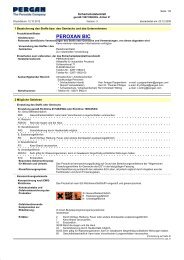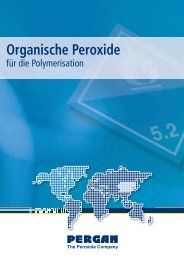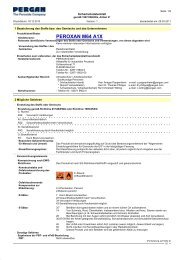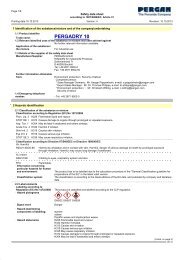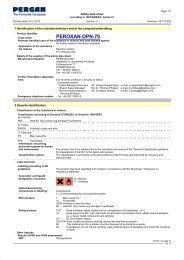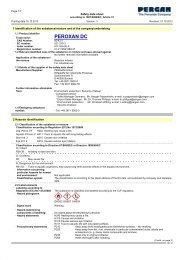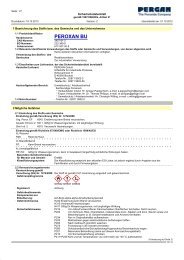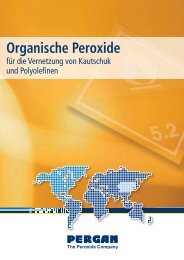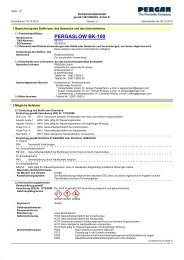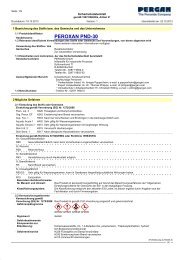PERGAQUICK A150 - Pergan GmbH
PERGAQUICK A150 - Pergan GmbH
PERGAQUICK A150 - Pergan GmbH
Create successful ePaper yourself
Turn your PDF publications into a flip-book with our unique Google optimized e-Paper software.
35.0.28<br />
Page 1/6<br />
Printing date 20.09.2012<br />
Safety data sheet<br />
according to 1907/2006/EC, Article 31<br />
Version: 3<br />
Revision: 01.08.2012<br />
1 Identification of the substance/mixture and of the company/undertaking<br />
· 1.1 Product identifier<br />
· Trade name: <strong>PERGAQUICK</strong> <strong>A150</strong><br />
· CAS Number: 3077-12-1<br />
· EC number: 221-359-1<br />
· 1.2 Relevant identified uses of the substance or mixture and uses advised against<br />
No further relevant information available.<br />
· Application of the substance /<br />
the preparation Accelerator for polymerisation / crosslinking<br />
For industrial use<br />
· 1.3 Details of the supplier of the safety data sheet<br />
· Manufacturer/Supplier: PERGAN <strong>GmbH</strong><br />
Hilfsstoffe für industrielle Prozesse<br />
Schlavenhorst 71<br />
D-46395 Bocholt<br />
Tel: +49 2871 9902-0<br />
Fax: +49 2871 9902-50<br />
· Further information obtainable<br />
from: Environment protection / Security of labour<br />
Competent person:<br />
* Sales Manager Germany: Mr. Ansgar Pappenheim, e-mail: a.pappenheim@pergan.com<br />
* Export Sales Manager: Mr. Dr. Thomas Philipps, e-mail: dr.philipps@pergan.com<br />
* Environment protection / : Mr. Christoph Wilting, e-mail: c.wilting@pergan.com<br />
Security of labour<br />
· 1.4 Emergency telephone<br />
number: - Tel: +49 2871 9902-0<br />
2 Hazards identification<br />
· 2.1 Classification of the substance or mixture<br />
· Classification according to Regulation (EC) No 1272/2008<br />
Eye Dam. 1 H318 Causes serious eye damage.<br />
Acute Tox. 4 H302 Harmful if swallowed.<br />
Skin Irrit. 2 H315 Causes skin irritation.<br />
· Classification according to Directive 67/548/EEC or Directive 1999/45/EC<br />
Xn; Harmful<br />
R22: Harmful if swallowed.<br />
Xi; Irritant<br />
R38-41: Irritating to skin. Risk of serious damage to eyes.<br />
· Information concerning<br />
particular hazards for human<br />
and environment: Not applicable.<br />
· Classification system: The classification is according to the latest editions of the EU-lists, and extended by company and literature<br />
data.<br />
· 2.2 Label elements<br />
· Labelling according to<br />
Regulation (EC) No 1272/2008 The substance is classified and labelled according to the CLP regulation.<br />
· Hazard pictograms<br />
~� ~�<br />
· Signal word<br />
· Hazard-determining<br />
GHS05 GHS07<br />
Danger<br />
components of labelling: 2,2'-[(4-methylphenyl)imino]bisethanol<br />
· Hazard statements H302 Harmful if swallowed.<br />
H315 Causes skin irritation.<br />
H318 Causes serious eye damage.<br />
· Precautionary statements P264 Wash thoroughly after handling.<br />
P280 Wear protective gloves/protective clothing/eye protection/face protection.<br />
P270 Do no eat, drink or smoke when using this product.<br />
P305+P351+P338 IF IN EYES: Rinse cautiously with water for several minutes. Remove contact lenses, if<br />
present and easy to do. Continue rinsing.<br />
P310 Immediately call a POISON CENTER or doctor/physician.<br />
P321 Specific treatment (see on this label).<br />
P362 Take off contaminated clothing and wash before reuse.<br />
P301+P312 IF SWALLOWED: Call a POISON CENTER or doctor/physician if you feel unwell.<br />
P332+P313 If skin irritation occurs: Get medical advice/attention.<br />
P501 Dispose of contents/container in accordance with local/regional/national/international<br />
regulations.<br />
(Contd. on page 2)<br />
GB
35.0.28<br />
Page 2/6<br />
Printing date 20.09.2012<br />
Safety data sheet<br />
according to 1907/2006/EC, Article 31<br />
Version: 3<br />
Revision: 01.08.2012<br />
Trade name: <strong>PERGAQUICK</strong> <strong>A150</strong><br />
· 2.3 Other hazards<br />
· Results of PBT and vPvB assessment<br />
· PBT: Not applicable.<br />
· vPvB: Not applicable.<br />
3 Composition/information on ingredients<br />
· 3.1 Chemical characterization: Substances<br />
· CAS No. Description 3077-12-1 2,2'-[(4-methylphenyl)imino]bisethanol<br />
· Identification number(s)<br />
· EC number: 221-359-1<br />
4 First aid measures<br />
(Contd. of page 1)<br />
· 4.1 Description of first aid measures<br />
· General information: Symptoms of poisoning may even occur after several hours; therefore medical observation for at least 48<br />
hours after the accident.<br />
?Z<br />
Take care of personal protection for the first aider.<br />
· After inhalation: In case of unconsciousness place patient stably in side position for transportation.<br />
Take affected persons into fresh air and keep quiet.<br />
· After skin contact: Immediately wash with water and soap and rinse thoroughly.<br />
Immediately remove contaminated clothing.<br />
· After eye contact: Rinse opened eye for several minutes under running water. Then consult a doctor.<br />
· After swallowing: Do not induce vomiting; call for medical help immediately.<br />
Rinse out mouth and then drink plenty of water.<br />
· 4.2 Most important symptoms<br />
and effects, both acute and<br />
delayed No further relevant information available.<br />
· 4.3 Indication of any immediate<br />
medical attention and special<br />
treatment needed No further relevant information available.<br />
5 Firefighting measures<br />
· 5.1 Extinguishing media<br />
· Suitable extinguishing agents: Use fire extinguishing methods suitable to surrounding conditions.<br />
· 5.2 Special hazards arising from<br />
the substance or mixture Under certain fire conditions, traces of other toxic gases cannot be excluded.<br />
· 5.3 Advice for firefighters<br />
· Protective equipment: Do not inhale explosion gases or combustion gases.<br />
· Additional information Self-protection first!<br />
6 Accidental release measures<br />
· 6.1 Personal precautions,<br />
protective equipment and<br />
emergency procedures Wear protective equipment. Keep unprotected persons away.<br />
· 6.2 Environmental precautions:<br />
Do not allow to enter sewers/ surface or ground water.<br />
?K@JL<br />
· 6.3 Methods and material for<br />
containment and cleaning up: Dispose contaminated material as waste according to item 13.<br />
Ensure adequate ventilation.<br />
Soak up with absorbant material (e. g. Vermiculit) and dispose of in accordance with government<br />
regulations.<br />
· 6.4 Reference to other sections See Section 7 for information on safe handling.<br />
See Section 8 for information on personal protection equipment.<br />
See Section 13 for disposal information.<br />
In case of large spillage the environmental authority should be informed.<br />
7 Handling and storage<br />
· 7.1 Precautions for safe<br />
handling Prevent formation of aerosols.<br />
(Contd. on page 3)<br />
GB
35.0.28<br />
Page 3/6<br />
Printing date 20.09.2012<br />
Safety data sheet<br />
according to 1907/2006/EC, Article 31<br />
Version: 3<br />
Revision: 01.08.2012<br />
Trade name: <strong>PERGAQUICK</strong> <strong>A150</strong><br />
(Contd. of page 2)<br />
Wear suitable respiratory protective device when decanting larger quantities without extractor facilities.<br />
Before break and at the end of work hands should be thoroughly washed.<br />
Avoid contact with skin and eyes.<br />
While using do not eat, drink or smoke.<br />
· Information about fire - and<br />
explosion protection: No special measures required.<br />
· 7.2 Conditions for safe storage, including any incompatibilities<br />
· Storage: Pay attention to the special requirements of your local autorithies for storing dangerous goods.<br />
· Requirements to be met by<br />
storerooms and receptacles: Prevent any seepage into the ground.<br />
Use only receptacles specifically permitted for this substance/product.<br />
· Information about storage in<br />
one common storage facility: Store away from peroxide.<br />
Store away from foodstuffs, drinks and feeding stuffs.<br />
· Further information about<br />
storage conditions: Keep container tightly sealed.<br />
· Recommended storage<br />
temperature (To maintain<br />
quality): 0 .... +30°C<br />
· 7.3 Specific end use(s) No further relevant information available.<br />
8 Exposure controls/personal protection<br />
· Additional information about<br />
design of technical facilities: No further data; see item 7.<br />
· 8.1 Control parameters<br />
· Ingredients with limit values<br />
that require monitoring at the<br />
workplace: Not required.<br />
· Additional information: The lists valid during the making were used as basis.<br />
· 8.2 Exposure controls<br />
· Personal protective equipment:<br />
· General protective and<br />
hygienic measures: The usual precautionary measures are to be adhered to when handling chemicals.<br />
Keep away from foodstuffs, beverages and feed.<br />
Immediately remove all soiled and contaminated clothing<br />
Wash hands before breaks and at the end of work.<br />
Avoid close or long term contact with the skin.<br />
Avoid contact with the eyes and skin.<br />
Do not eat, drink, smoke or sniff while working.<br />
Use skin protection cream for skin protection.<br />
Be sure to clean skin thoroughly after work and before breaks.<br />
· Respiratory protection: Not necessary if room is well-ventilated.<br />
Use suitable respiratory device when it exceed exposure limit and when insufficiently ventilated.<br />
`Q<br />
Filter A2<br />
· Protection of hands: Only use chemical-protective gloves with CE-labelling of category III.<br />
Selection of the glove material on consideration of the penetration times, rates of diffusion and the<br />
degradation<br />
`S<br />
Protective gloves<br />
· Material of gloves The selection of the suitable gloves does not only depend on the material, but also on further marks of<br />
quality and varies from manufacturer to manufacturer.<br />
Butyl rubber, BR<br />
Fluorocarbon rubber (Viton)<br />
Nitrile rubber, NBR<br />
Neoprene<br />
· Penetration time of glove<br />
material The exact break trough time has to be found out by the manufacturer of the protective gloves and has to be<br />
observed.<br />
· Eye protection:<br />
Tightly sealed goggles<br />
`R<br />
(Contd. on page 4)<br />
GB
35.0.28<br />
Page 4/6<br />
Printing date 20.09.2012<br />
Safety data sheet<br />
according to 1907/2006/EC, Article 31<br />
Version: 3<br />
Revision: 01.08.2012<br />
Trade name: <strong>PERGAQUICK</strong> <strong>A150</strong><br />
· Body protection:<br />
9 Physical and chemical properties<br />
Protective work clothing<br />
· 9.1 Information on basic physical and chemical properties<br />
· General Information<br />
· Appearance:<br />
· Form: Fluid<br />
· Colour: Dark yellow<br />
· Odour: Characteristic<br />
· pH-value (10 g/l) at 20°C: ca. 9 - 11<br />
· Change in condition<br />
· Melting point/Melting range: 300 mg/kg (rattus)<br />
· Primary irritant effect:<br />
· on the skin: Irritant to skin.<br />
· on the eye: Strong irritant with the danger of severe eye injury.<br />
· Sensitization: No sensitizing effects known.<br />
GB<br />
(Contd. on page 5)
35.0.28<br />
Page 5/6<br />
Printing date 20.09.2012<br />
Safety data sheet<br />
according to 1907/2006/EC, Article 31<br />
Version: 3<br />
Revision: 01.08.2012<br />
Trade name: <strong>PERGAQUICK</strong> <strong>A150</strong><br />
12 Ecological information<br />
· 12.1 Toxicity<br />
· Aquatic toxicity: No further relevant information available.<br />
· 12.2 Persistence and<br />
degradability No further relevant information available.<br />
· 12.3 Bioaccumulative potential No further relevant information available.<br />
· 12.4 Mobility in soil No further relevant information available.<br />
· Additional ecological information:<br />
· General notes: Water hazard class 2 (German Regulation) (Self-assessment): hazardous for water<br />
Do not allow product to reach ground water, water course or sewage system.<br />
Danger to drinking water if even small quantities leak into the ground.<br />
· 12.5 Results of PBT and vPvB assessment<br />
· PBT: Not applicable.<br />
· vPvB: Not applicable.<br />
· 12.6 Other adverse effects No further relevant information available.<br />
13 Disposal considerations<br />
(Contd. of page 4)<br />
· 13.1 Waste treatment methods<br />
· Recommendation Can be burned with household garbage after consulting with the waste disposal facility operator and the<br />
pertinent authorities and adhering to the necessary technical regulations.<br />
· Waste disposal key: Please contact your hazardous waste disposers to assign the right EWC-(European waste catalog)-number.<br />
· Uncleaned packaging:<br />
· Recommendation: Packagings that may not be cleansed are to be disposed of in the same manner as the product.<br />
· Recommended cleansing<br />
agents: Water, if necessary together with cleansing agents.<br />
14 Transport information<br />
· 14.1 UN-Number<br />
· ADR Void<br />
· 14.2 UN proper shipping name<br />
· ADR Void<br />
· 14.3 Transport hazard class(es)<br />
· ADR<br />
· Class Void<br />
· 14.4 Packing group<br />
· ADR Void<br />
· 14.6 Special precautions for user Not applicable.<br />
· 14.7 Transport in bulk according to Annex II of MARPOL73/78 and<br />
the IBC Code Not applicable.<br />
15 Regulatory information<br />
· 15.1 Safety, health and environmental regulations/legislation specific for the substance or mixture<br />
· National regulations:<br />
· Other regulations, limitations and prohibitive regulations<br />
· Please note: Take care of the respective local regulations.<br />
· 15.2 Chemical safety<br />
assessment: A Chemical Safety Assessment has not been carried out.<br />
16 Other information<br />
This information is based on our present knowledge. However, this shall not constitute a guarantee for any specific product features and shall<br />
not establish a legally valid contractual relationship.<br />
· Department issuing MSDS: Environment protection / Security of labour<br />
· Contact: Tel: +49 2871 9902-0<br />
E-mail: mail@pergan.com<br />
· Abbreviations and acronyms: RID: Règlement international concernant le transport des marchandises dangereuses par chemin de fer (Regulations Concerning the<br />
International Transport of Dangerous Goods by Rail)<br />
(Contd. on page 6)<br />
GB
35.0.28<br />
Page 6/6<br />
Printing date 20.09.2012<br />
Safety data sheet<br />
according to 1907/2006/EC, Article 31<br />
Version: 3<br />
Revision: 01.08.2012<br />
Trade name: <strong>PERGAQUICK</strong> <strong>A150</strong><br />
· * Data compared to the<br />
previous version altered.<br />
(Contd. of page 5)<br />
ADR: Accord européen sur le transport des marchandises dangereuses par Route (European Agreement concerning the International Carriage<br />
of Dangerous Goods by Road)<br />
GHS: Globally Harmonized System of Classification and Labelling of Chemicals<br />
EINECS: European Inventory of Existing Commercial Chemical Substances<br />
CAS: Chemical Abstracts Service (division of the American Chemical Society)<br />
LC50: Lethal concentration, 50 percent<br />
LD50: Lethal dose, 50 percent<br />
GB



